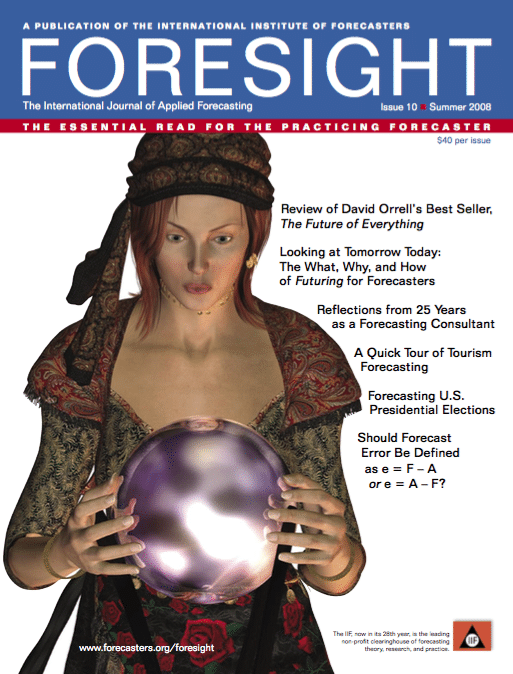FORESIGHT, Issue 10
$45.00
Description
Summer 2008 Issue
Articles
-
- Looking at Tomorrow Today – The What, Why and How of Futuring for Forecasters by Roy Pearson
Out with the beaded curtains, dripping candles, and crystal balls, says Roy Pearson in this, his first column as Foresight’s Forecasting Intelligence Editor. These days, trying to foretell the future has become a respected and respectable line of work. Roy writes that today’s futurists utilize methods and practices most forecasters can admire, adapt, and incorporate into their own processes – and very possibly improve their forecasting accuracy as a result. - Lessons Learned – Reflections from 25 Years as a Forecasting Consultant by Antonio Garcia-Ferrer
Antonio presents a contrasting pair of studies performed during his consulting career, illustrating the conditions that distinguish a successful project outcome from a failure. He offers provocative advice for implementation and management of forecasting projects. - Life-Cycle Forecasting for New Products – The HP Approach to Forecasting Printer Demand by Jerry Shan, Matthew Reimann, and Fereydoon Safai
Forecasting for products with short life cycles is a well-known challenge. Jerry, Matthew, and Fereydoon describe an approach they developed to forecast printer demand at Hewlett-Packard. The approach has two components: one, which they call the automatic Product Life Cycle (PLC) method, is applied to product forecasts; the other, the Statistical Prediction for Aggregates (SPA) method, is applied to a product family/financial market category. HP believes this approach has improved forecasting performance. - Forecasting U.S. Presidential Elections – A Brief Overview by Randall Jones and Alfred Cuzan
With the November 2008 U.S. presidential election looming, Randall and Alfred describe the enduring forecasting models that have been created by economists and political scientists for predicting the results of this quadrennial ritual. The most stable models since 1996 have consistently forecast the election winner, with an average error of less than 3%. While not all of the players have issued their forecasts for this year’s final vote, the models suggest that the outlook for the Republican Party is negative. - Book Review by Paul Fields
The Future of Everything: The Science of Prediction by David Orrell - Forecast Accuracy Measurement: Should We Define Forecast Error as e=F-A or A-F? Survey edited by Kesten Green and Len Tashman
- HOT New Research Column: A Quick Tour of Tourism Forecasting by Paul Goodwin
- Looking at Tomorrow Today – The What, Why and How of Futuring for Forecasters by Roy Pearson







